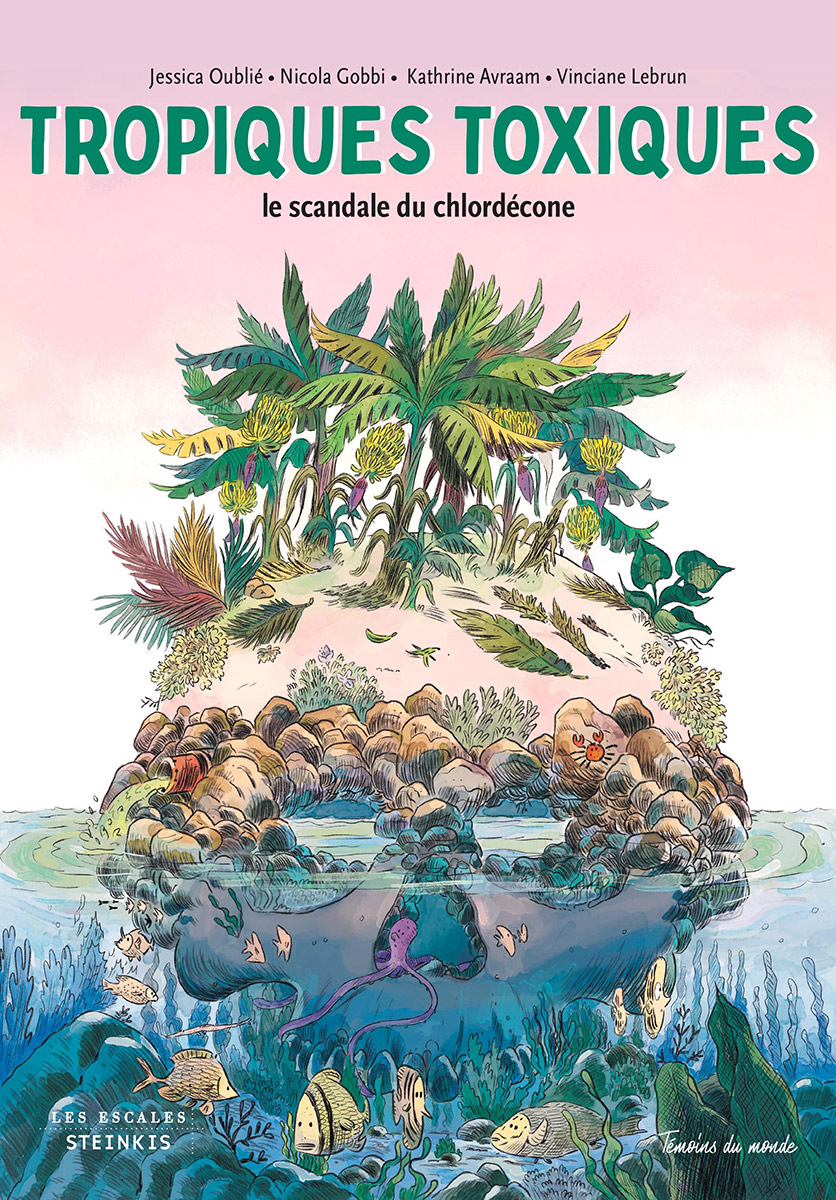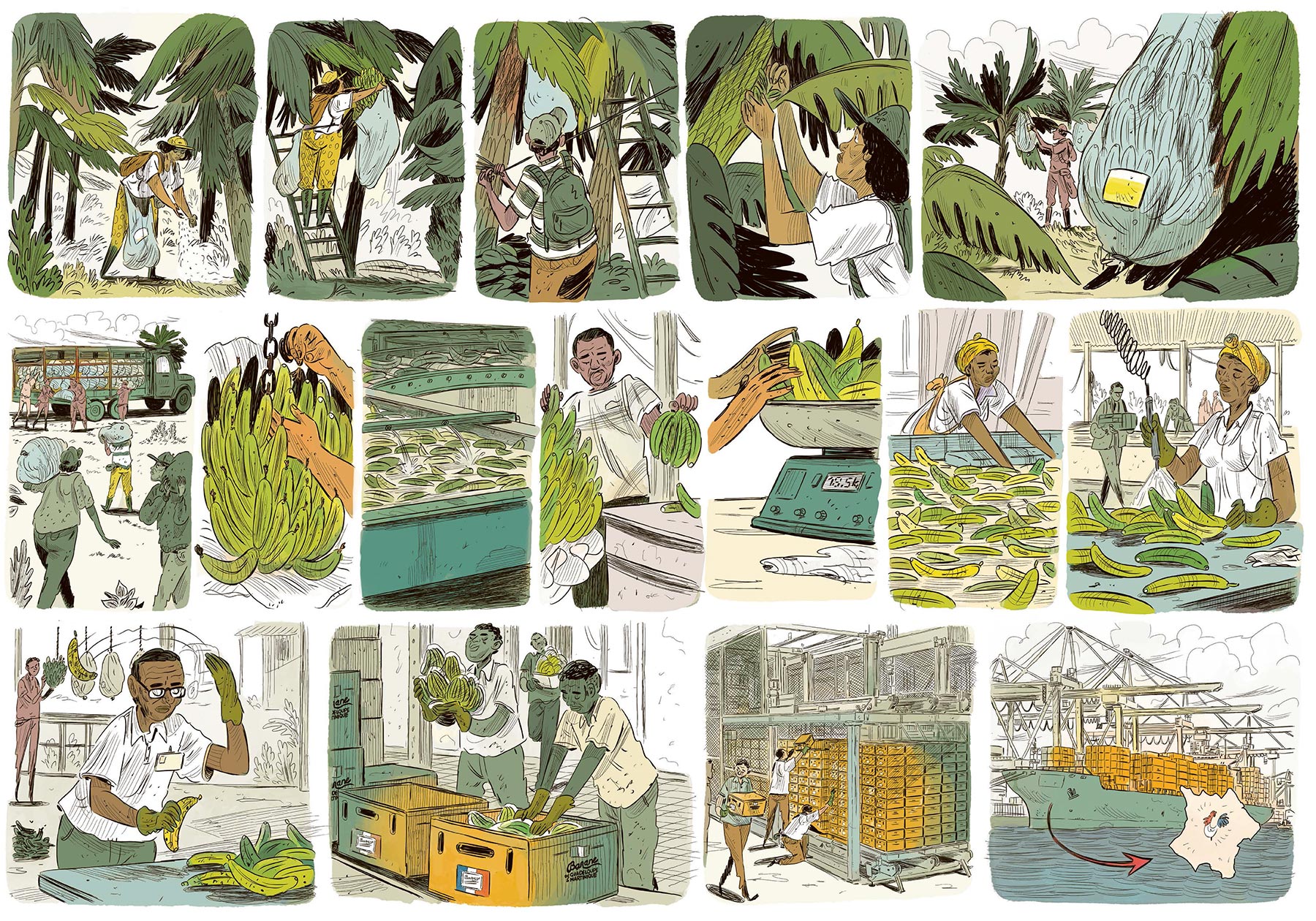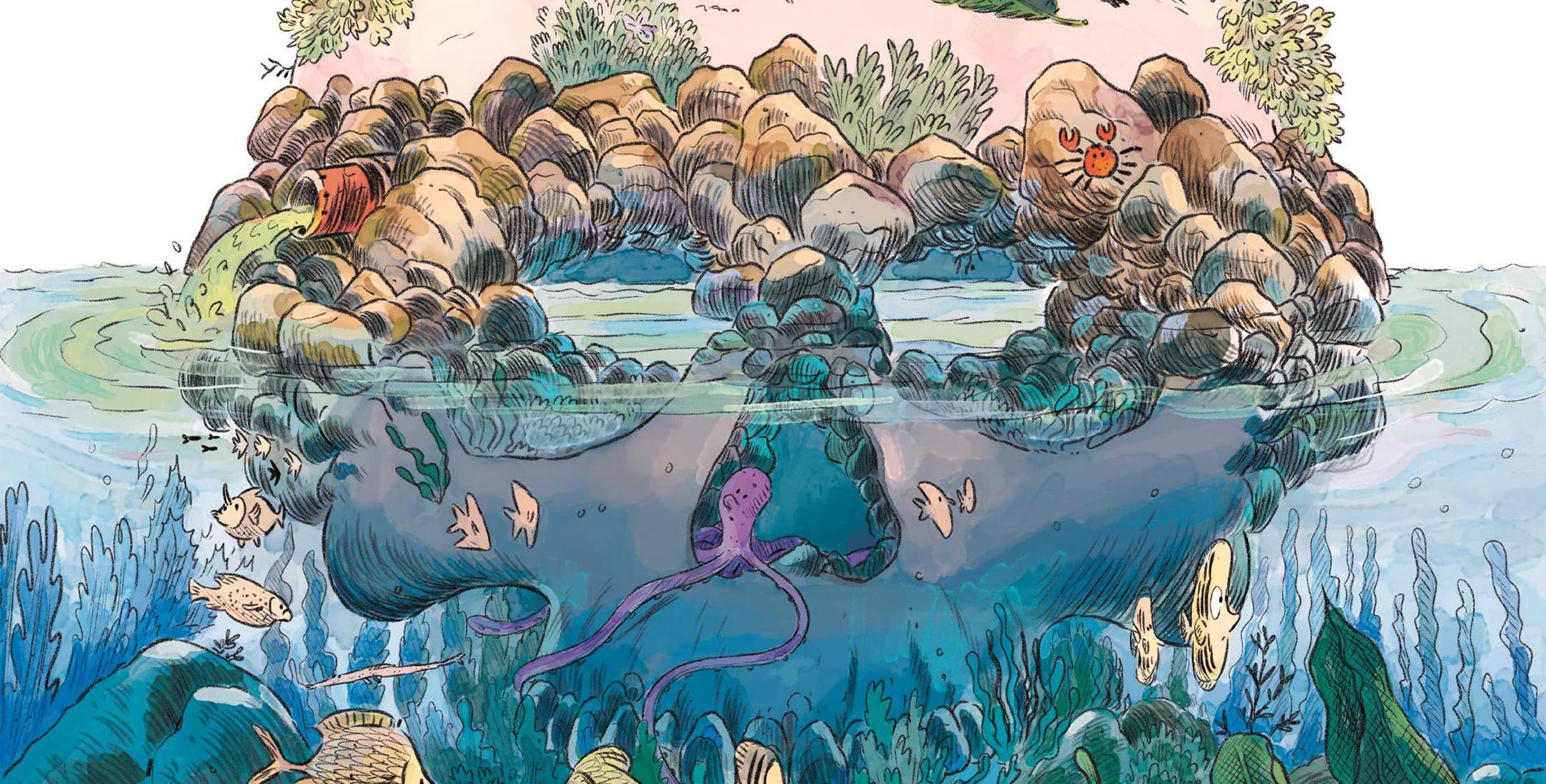This story can also be found in our Spring 2021 issue of Life & Thyme Post, our limited edition newspaper for Life & Thyme members. Subscribe
On August 3, 1492—the day that Christopher Columbus set sail from Spain, later having a fatal encounter with the indigenous people he met in the “West Indies”—the world of the garden changed.
– Jamaica Kincaid, “The Disturbances of the Garden”
“Every day, we eat a little bit of poison,” says Jessica Oublié as she describes the inescapable realities of chlordecone pollution. “It is in our water, in the soil, animals, marine life, and in our bodies.” Chlordecone—a toxic pesticide extensively used throughout banana plantations in the French Caribbean—can remain in the environment for up to seven hundred years.
Oublié is the author of Tropiques Toxiques: Le Scandale du Chlordécone (Toxic Tropics: The Chlordecone Scandal), a graphic novel published in October 2020. Toxic Tropics is the culmination of a two-year research project that investigates the unfolding aftermath of chlordecone poisoning in Guadeloupe and Martinique.
After moving from Paris to Guadeloupe in 2018, Oublié was confronted with the simultaneous ubiquity of environmental catastrophe on the island and its invisibility in France. Toxic Tropics detangles the details that made this ongoing disaster possible. Interviews with 136 people—farmers, activists, epidemiologists, journalists and historians—across France, Belgium, the United States, and the French Caribbean reveal the depth of government culpability.
France authorized the use of chlordecone in their overseas banana plantations from 1972 to 1993, although the Ministry of Agriculture had previously recognized it as a toxic chemical. As a result, 95% of people in Guadeloupe and 92% of people in Martinique now have traces of chlordecone in their blood. Chlordecone disrupts the body’s natural hormone systems which can lead to developmental, reproductive, immune and neurological disorders.
This willful production of bodily and environmental harm unravels histories of colonial violence and what literary scholar Saidiya Hartman describes in Lose Your Mother as the afterlife of slavery: “…black lives are still imperiled and devalued by a racial calculus and a political arithmetic that were entrenched centuries ago,” Hartman writes. “This is the afterlife of slavery—skewed life chances, limited access to health and education, premature death, incarceration and impoverishment.”
Guadeloupe and Martinique, known as Les Antilles, are overseas territories that are legally designated departments of France. These islands are an extension of the mainland/metropole/l’hexagone in the Caribbean Sea. In this everyday language used to describe the relationship between the archipelago and the elsewhere-state that steers it, the grammar of colonial histories emerge—histories that (re)create catastrophe as normative and necessary for the French empire’s existence.
By 1635, the French settled in the Caribbean to develop an agricultural enterprise that would generate wealth for the metropole. They were met with resistance by the Arawak and Carib—the Indigenous people of the islands—who fought against European invasion for centuries, beginning with Spain, whose attempt at conquest was initiated by Columbus’ arrival. After decades of slaughter, however, the French officially colonized Martinique and Guadeloupe.

As writer and philosopher Édouard Glissant articulates in Poetics of Relation, in enacting this genocide in the Antilles, any sacred filiation to the land by its people was uprooted. This transformed the land into territory, which is always the “basis for conquest … defined by its limits, and they must be expanded.” This rupture that is the colonial project, set into motion the material practices that brought modernity into being: dispossession, genocide, slavery and extraction.
France started importing slaves from western Africa to the Antilles in 1650. This influx of labor developed and expanded plantation agriculture—a system of farming that focuses on large-scale cultivation of single crops for export, known as cash crops. In the Antilles, cash crops included indigo, cacao, coffee, and the most lucrative: sugar cane. Sugar cane yielded so much wealth that colonists referred to the islands as îles à sucre (the sugar islands). Slave labor allowed those who owned slaves to maximize profits and accumulate the wealth that initiated industrialization. In other words, the plantation model is what made and continues to define global capitalism.
In 1848, France abolished slavery after nearly two centuries of importing nearly 700,000 enslaved people to the islands. To ensure that abolition did not disrupt the economic viability of their colonies, France provided 126 million francs to the Antilles. Six million francs were directly distributed to slave owners as compensation for their loss of property (slaves) and the remainder created the islands’ banking system. Abolitionists proposed that in setting up these banks, newly freed slaves could access loans to develop their own wealth. In practice, békés—a Creole word that describes slave owners and their descendants— actively prevented former slaves from accessing these funds, foreclosing any possibilities of material emancipation for slaves. The abolition of slavery then, as historian and writer Françoise Vergès writes in Resolutely Black, “represented neither a break from the past nor the founding of a new order.”
Békés wielding power and violence to prevent the actualization of Black autonomy is integral to the persistence of the plantation system. In Toxic Tropics, historian Myriam Cottias elucidates, “after abolition, the modes of domination and structure of labor did not really change. The newly freed continued to work on the same land and for the same masters that enslaved them.” This form of sharecropping, a system that constituted post-abolition slave societies, exploited Black labor in exchange for a fraction of the sales of sugar cane.
Approaching the twentieth century, a deteriorating sugar cane industry and broadening colonial appetite marked the emergence of mass banana cultivation. Ancient traces, oral histories, and sacred texts reveal the banana grew in forests throughout the tropics, providing sustenance across continents. In the Antilles, cultivation of banana plants grew to feed the increasing number of slaves arriving on the islands. Bananas offered an inexpensive and nutritionally-dense food source for slaves as they performed the brutal daily labor plantations required. So the banana—the plantain specifically—became an important food for slave communities. The planting and harvesting of bananas continued for the newly freed, and it was this already existing small-scale cultivation of the crop—part of the Créole garden—that enabled békés to transition the banana into a cash crop. This shift was marked in 1907 when the first batch of bananas was exported to France.
Plantation-produced wealth invented the capitalist world economy by creating technologies designed to expand empires. In Banana: The Fate of the Fruit that Changed the World, author Dan Koeppel explains the colonial enterprises that later became Dole and Chiquita “invented radio networks to allow communication between plantations and cargo vessels approaching port. Banana fleets were the first vessels with built-in refrigeration and banana companies the first to use controlled atmospheres and piped-in chemicals to delay ripening.” These imperial technologies developed the mechanisms for global trade, networks and markets—making a multi-billion dollar banana industry possible. Dole and Chiquita are now among five corporations that control the banana market, an economy that generates at least eight billion dollars annually according to the U.N. Food and Agriculture Organization.

By the time Guadeloupe and Martinique became overseas territories of France in 1946, the sugar cane industry collapsed and their economies were entirely dependent on exporting bananas. As illuminated in Toxic Tropics, over 70% of bananas produced were exported to France and the banana industry became the largest employer in the Antilles. Folding the former colonies into the empire meant the islands could still be in total service to the mainland. Further reproducing the plantation model, békés established import-export companies, allowing them to control trade with the metropole. This economic monopoly multiplied wealth and centralized the power békés continue to have in the French Caribbean.
In 1962, this reliance on banana exports was underscored when France issued protections for the Antillaise banana industry in an increasingly competitive market. To contend with the American dominance of the global banana trade, France decided all imported bananas would come from the Antilles (two-thirds) and former French colonies in Africa (one-third). Banana production and revenue grew exponentially.
During this surge, weevils—insects that damage and kill banana plants—developed greater resistance to the pesticides widely used for their extermination. To eliminate this threat to their booming industry, banana companies turned to chlordecone. An insecticide, chlordecone was developed in the United States in 1952 by Allied Chemical, a Virginia-based company invested in the industrial production of chemicals. In Toxic Tropics, Oublié explores French national archives and examines the original requests filed for chlordecone authorization from the state. The historical records illuminate the scope of knowledge the French Ministry of Agriculture had about the toxicity of the pesticide.
Between 1968 and 1969, the Ministry of Agriculture rejected two requests for commercial use of chlordecone; studies conducted on rats revealed evidence of toxicity. In their review, the committee stated, “short-term and long-term toxicity show clear cumulative effects. In rats, a diet of 50ppm [of chlordecone] caused the death of all animals after six months.” However, in 1971, with active involvement of banana industry lobbyists, chlordecone was declassified from toxic to dangerous, allowing it to enter the market. The following year, the state granted a one-year sales provision with the explicit instruction that further use would require an environmental impact assessment of the pesticide. This analysis was never provided and the use of chlordecone continued even as additional conclusive evidence of its ultra-toxicity emerged.
In 1973, Allied Chemical contracted the manufacturing of chlordecone to a smaller company, Life Science Products (LSP). Two years later in 1975, twenty-nine factory workers at the LSP plant in Hopewell, Virginia, were hospitalized after exhibiting severe symptoms including tremors, difficulty breathing, rapid eye movements, and chest pain caused by chlordecone poisoning. The state health department closed the plant and launched an investigation, which also found the plant’s wastewater polluted the local river, contaminating marine life. The river was closed and commercial fishing was banned, devastating local industries. Allied Chemical and LSP eventually settled a federal lawsuit for a combined $16.5 million and the Environmental Protection Agency banned the production and distribution of chlordecone in the United States in 1976.
The following year, the first study showing widespread pollution in Guadeloupe was published. Researchers found chlordecone in the soil and rivers throughout the island and highlighted the necessity of further studies. But despite the Hopewell disaster and knowledge of widespread contamination in Guadeloupe, it took another fourteen years for France to stop using chlordecone. Although it was initially banned in 1991, the French state granted a two-year extension for its use in the Antilles.
The use of chlordecone in the French Caribbean has polluted ecosystems fundamental to sustaining life. Interviewed in Toxic Tropics, Sarra Gaspard, a chemistry professor at the University of the Antilles in Guadeloupe states, “if no process of depollution is initiated, it is estimated that the pollution will last five hundred to seven hundred years.” The low biodegradability of the molecule enables its persistence in soil and water, which has inevitably contaminated food chains—the primary way people are exposed to chlordecone. Studies conducted by France’s National Institute of Agricultural Research show that one-third of Martinique’s agricultural land and one-fifth in Guadeloupe contains chlordecone. This limits the possibilities of planting and harvesting healthy food on the islands which already import 90% of all consumed goods.
Chlordecone contamination of food sources happens at the root level of plants; this means that banana plants are least vulnerable and root vegetables the most vulnerable to absorbing the chemical. As a result, growing root vegetables like sweet potatoes, carrots, ginger, turmeric and turnips—essentials in Antillaise cuisine—free of chlordecone is challenging, and perhaps unlikely on up to one third of land. Additionally, 65% of the waterways in the Antilles are polluted, taking a toll on the fishing industry. The restriction of commercial fishing has increased unemployment and made locally-sourced fish—another staple in Antillaise cuisine—inaccessible. This deterioration of land, water and food practices continues to diminish the capacity for self-sufficiency and sovereignty.
The sum of chlordecones calamitous impact stretches across the entire world of these islands. As Oublié describes, “it’s part of our every day. It is like water, air, sun, nature. It is so much to imagine; it is bigger than life.” The everydayness of this incalculable violence renders it ordinary and always in service to sustaining the mainland: France. The suffering that happens in the process is negligible, which is to say that empire and whiteness are inextricable from anti-Black violence.
The afterlife of slavery is living in repetitive disaster(s) and in what Christina Sharpe articulates in In the Wake: On Blackness and Being as weather. The weather is the anti-Black climate that is the totality of our environments, (re)produced by the plantation that is “the past that is not past reappears, always, to rupture the present,” as Sharpe writes. The afterlife of slavery sutures modernity, meaning Blackness—rather, anti-Blackness—is what makes this world possible. In the Antilles, the afterlife of slavery is three béké families owning 40% of the surface of the islands. It is having a premature birth rate that is four times higher than the mainland’s average. It is the five hundred new cases of prostate cancer diagnosed every year on each island, which is two times higher than in the metropole, and among the highest in the world.
In 2008, France launched The Chlordecone Plan in response to ongoing calls for state intervention. This multi-year plan emphasizes studying the scope of pollution and implementing measures to reduce exposure. A tangible strategy it has implemented is meeting with families and discussing ways to avoid chlordecone, such as growing different foods in gardens, testing soil, or changing food practices. Now in its fourth phase (2021-2027), the government’s plan is widely criticized for shifting responsibility to the individual rather than providing policy changes, compensation, or actionable strategies for depollution.
The state failed to recognize the magnitude of chlordecone’s devastation until 2018. French President Emmanuel Macron stated, “chlordecone pollution is an environmental scandal … the state must take its share of responsibility.” But people in the Antilles have been mobilizing for accountability for decades, specifically demanding compensation for loss of employment and for the health conditions caused by chlordecone. In 2006, seven organizations filed a complaint against the state for poisoning their islands, citing reckless endangerment. The case was brought to the High Court of Paris on January 20 and 21, 2021—nearly fifteen years after it was first submitted. During the proceedings, judges informed all parties that the statute of limitations could be reached, potentially leading to a dismissal of the complaint.
An egregious violation of due process, this pending decision has reignited public outrage. Mass mobilizations took place on February 27 from Paris to Fort-de-France in Martinique where up to 15,000 people protested the state’s refusal of material intervention. Protesting for your life to matter is part of the afterlife of slavery too.
The afterlife of the French Caribbean is the surrealism of having to persist through the impossibilities of enclosure on islands where “the unreal way in which it is beautiful now is the unreal way in which it was always beautiful,” as Jamaica Kincaid describes in A Small Place. Living in the simultaneity of such enduring beauty and collapse is to experiment with ways to inhabit the uninhabitable. In the Antilles, this looks like communities developing microcircuits of farmers and vendors exploring chlordecone-free cultivation, families diversifying food crops in their garden, scientists like Sarah Gasspard who are testing ways to decompose chlordecone and depollute ecosystems, and people mobilizing for the resources they are owed.
This kind of persistence that is required for survival in an anti-Black world in so many ways exceeds what language can articulate. In this afterlife, what are the possibilities for redress when catastrophe, rather than being a single event, is the very condition of living?







Our comments section is for members only.
Join today to gain exclusive access.